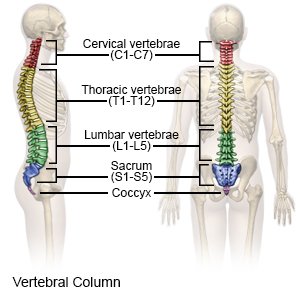Computed Tomographic Myelography
Medically reviewed by Drugs.com. Last updated on Aug 4, 2025.
WHAT YOU NEED TO KNOW:
Computed tomographic (CT) myelography is a procedure to examine your spinal canal. Contrast liquid is used to help healthcare providers see your nerves, bones, or spinal cord more clearly.
 |
HOW TO PREPARE:
Before your procedure:
- Your healthcare provider will tell you how to prepare. Arrange to have someone drive you home after the CT.
- Tell your provider about all medicines you currently take. He or she will tell you if you need to stop any medicine for the CT, and when to stop. He or she will tell you which medicines to take or not take on the day of the CT.
- Tell your provider if you have ever had an allergic reaction to contrast liquid. You may be given medicine to help prevent a reaction.
- If you are a woman, tell your provider if you know or think you may be pregnant.
- You may need to have blood or urine tests. You may also need x-rays or an MRI.
The night before your procedure:
You will be told if it is okay to eat or drink before the test.
The day of your procedure:
- You or a close family member will be asked to sign a legal document called a consent form. It gives healthcare providers permission to do the procedure or surgery. It also explains the problems that may happen, and your choices. Make sure all your questions are answered before you sign this form.
- Take only the medicines your healthcare provider told you to take.
- An IV will be placed in a vein. You may get medicine or liquid through the IV.
- Local anesthesia is used to numb the area where the needle will be inserted.
WHAT WILL HAPPEN:
What will happen:
- You will be asked to lie on your side on an x-ray table. Your healthcare provider will insert a needle between the bones of your spine and into your spinal canal. He or she will use an x-ray with a monitor to carefully guide the needle. Contrast liquid will be used to help your provider see your nerves, bones, or spinal cord more clearly. You may feel warm after the liquid is injected. The table will be tilted so the liquid can move through your spinal canal.
- A series of x-rays may be taken while you are moved into different positions. A CT scan of your spine will be done. If the contrast liquid is made with oil, it will be removed. The needle will be removed, and the injection site will be covered with a bandage or surgical tape.
After your procedure:
You will be taken to a room to rest for several hours. Healthcare providers will monitor you closely for any problems. Do not get out of bed until your healthcare provider says it is okay. When your healthcare provider sees that you are okay, you will be able to go home or be taken to your hospital room. Tell your healthcare provider if you have a headache, back or neck pain, or tingling, numbness, or weakness below your waist.
- You may be asked to drink more liquids than usual. You may need IV fluids. Liquids will help flush the contrast liquid out of your body.
- A neurologic exam will check how your pupils react to light. Healthcare providers may also check your memory, hand grasp, foot or leg movement, and balance.
- You may develop a headache during the first few hours after your procedure. The headache may be mild to severe and may get worse when you sit up or stand. Your healthcare provider will monitor the location where the needle was inserted for possible leaking fluid. Fluid loss from your spinal column may increase your risk for a headache.
CONTACT YOUR HEALTHCARE PROVIDER IF:
- You have a skin infection or a wound near the area where the procedure will be done.
- Your skin is itchy, swollen, or you have a rash.
- You have a fever.
- You have questions or concerns about your procedure.
Risks
CT myelography may increase your risk for a headache, neck or back pain, nausea, or vomiting. You may have bleeding, or spinal fluid may leak from the injection site. The procedure may harm a disc, nerves, or your spinal cord. The contrast liquid used during the procedure may cause an allergy, seizures, or brain problems. The liquid may also damage your kidneys.
Related medications
Care Agreement
You have the right to help plan your care. Learn about your health condition and how it may be treated. Discuss treatment options with your healthcare providers to decide what care you want to receive. You always have the right to refuse treatment.© Copyright Merative 2025 Information is for End User's use only and may not be sold, redistributed or otherwise used for commercial purposes.
The above information is an educational aid only. It is not intended as medical advice for individual conditions or treatments. Talk to your doctor, nurse or pharmacist before following any medical regimen to see if it is safe and effective for you.
Further information
Always consult your healthcare provider to ensure the information displayed on this page applies to your personal circumstances.
